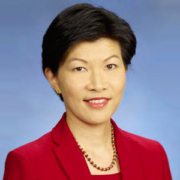Spotlight on Asia: What Does Gender Diversity in Asia Look Like in 2021?
 During the month of August, The Glass Hammer looks to the state of gender diversity in business and among leaders in Asia. The region is ahead globally in some facets, behind in others, and facing opportunity gaps where more women are needed.
During the month of August, The Glass Hammer looks to the state of gender diversity in business and among leaders in Asia. The region is ahead globally in some facets, behind in others, and facing opportunity gaps where more women are needed.
Here’s a brief overview of the key themes we see happening across Asia now:
Gains in Women Executives in ASEAN Region
According to a Grant Thornton report 2020, the greater Asian region was split when it comes to women in executive leadership.
The global average is 29% (on par with North America).
While ASEAN (Association of South East Asia Nations) tied with Eastern Europe at 35% to rank second highest in women in senior management roles globally, after Africa (38%), APAC (Asia-Pacific) had the world’s lowest representation (27%).
The ASEAN region showed very impressive growth from 28% in 2019 to 35% in 2020, thanks to a range of initiatives around diversity.
In 2018, prior to COVID-19, McKinsey estimated that advancing women’s equality in Asia-Pacific could boost the collective regional GDP by 12% by 2025 to $4.5 trillion.
Still A “1 Woman” Boardroom in Asia
A significant gap exists between women’s representation in senior management and their presence in the board room in Asia, where Asia lags behind.
According to the Egon Zehnder 2020 Global Board Diversity Tracker, only 73% of boards in Asia had at least one woman (89% globally). Only 33% had at least two women (70% globally) and 12% had at least 3 (49% globally).
The data shows only 12% of Asia board seats are held by women (23% globally), and only 16% of new appointments in 2020 were women (compared to 30% globally).
In China, women hold 12% of seats too, though only 29% of boards have at least two women and only 10% had 3 or more. In India, women fair much better – holding 17% of seats. 60% of boards have at least two women and 23% have at least three.
Arguing the financial case for diversity, the Board Gender Diversity in ASEAN report found companies with over 30% women representation had significantly greater financial performance (3.8% ROA) relative to boards with no women (2.4% ROA). Even one woman helped, according to the authors, but the financial performance difference increased with representation, especially at over 30% women.
Women in Tech Relatively Strong in ASEAN But More Are Needed
The global demand for digital talent outpaces the supply, including in Asia-Pacific. BCG reports that in the first quarter of 2020, 5% of technology roles went unfilled in Singapore.
Women’ participation in tech in Southeast Asia (32%) outpaces the global average (28%), and mature markets like the UK and Australia, being on par with the US. But despite the relatively high numbers, BCG says a significant tech gap remains. Across countries, women’s representation in tech in ASEAN lags relative to other industries.
The key “moments of truth” that must be supported in a women’s journey into a long-term career in the technology sector, according to the consultancy group’s research, include: their choice of major at college, selection of first job and decision to stay with a technology career once they’ve started.
As the dynamic is different in each country across these key truth points, the interventions to encourage and foster diversity must be tailored to each country’s context. In Thailand, women are 48% of tech graduates but only 42% of tech jobs (the highest % across ASEAN countries). Whereas in Singapore, women make up only 29% of tech graduates but comprise 41% of the tech workforce ,due to demand.
The vast majority of women in tech feel they have benefitted from diversity programs and 65% feel tech does better than most industries in tailoring programs to women, yet BCG argues more tailored efforts are needed at the “moments of truth” points.
Opportunity Gaps for Women in Asia Pacific
Per the LinkedIn Opportunity Index 2020, developing markets – including in Asia Pacific – are generally more confident about having access to opportunities: India (121), Indonesia (117) and China (116) top their list, while Japan comes in last (80).
But LinkedIn, according to Feon Ang, Managing Director, APAC, also found that women felt they had less opportunities than men, and COVID-19 not only disproportionally affected women but also their outlook on the future. One in three women in APAC felt that gender was a significant barrier to opportunity.
The research showed that 41% of women in APAC felt they had fewer career development opportunities than men, with that sentiment being strongest in China (44%), Malaysia (45%), Japan (47%) and Singapore (49%). Whereas in India, 4 of every 5 women felt they’d missed offers or opportunities due to gender.
The challenges facing women vary as well. Ang cites that “lack of time” is the main barrier to opportunities for women in countries such as India, Philippines and Singapore. Whereas “lack of professional skills” is the primary barrier for women in Japan. And in China and India, women feel they have a “lack of guidance through networks and connections.”
Less than a fourth of working professionals in APAC feel that their organizations are prioritizing gender diversity. Managing familial responsibilities comes up as a challenge to career development for many APAC women (45%) especially in India (71%).
Where are the Women Executives in Japan?
In Japan, women hold only 15% of management roles according to McKinsey, only halfway to the country’s 30% target. In 2019, Japan was ranked at 121 out of 153 in the World Economic Forum’s gender-equality index, the lowest among developed nations.
In research, McKinsey identified a gap in career-advancement goals. Japanese women are less likely to indicate they want a promotion than men (15 points lower), yet also more likely to feel gender is in the way and less confident. Overall men and women in Japan have the same hesitations towards promotion, but more women feared they would not be able to manage work/life balance.
When it came to what motivates aspirations for promotion, Japanese women tended to cite external recognition of their talent and strengths and the personal growth opportunity. Japanese men cite financial benefits, social status and rewards more.
Whereas the financial and status incentives are enough to motivate men, organizations like IBM are learning that women in Japan are more compelled when both witnessed for their personal skills and talents, and engaged individually on how advancing would particularly impact their own development.
Regional Diversity & Inclusion
LinkedIn’s Ang cites conversations on diversity and inclusion that include male allies; more women in leadership roles; family-friendly and flexible working policies; stronger mentoring and networking; and investment in learning and development as key measures for organizations to help close the opportunity gaps for women in Asia.
By Aimee Hansen








